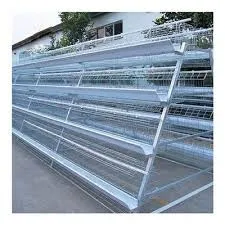Exploring the Benefits and Management Techniques for Layer Chickens in Poultry Cages
Aug . 13, 2024 19:06 Back to list
Exploring the Benefits and Management Techniques for Layer Chickens in Poultry Cages
The Importance of Poultry Cages for Layer Chickens
Layer chickens, renowned for their ability to produce eggs, play a crucial role in the poultry industry. One of the most significant factors affecting their productivity and welfare is the housing system. Among these housing systems, poultry cages designed specifically for layer chickens have become increasingly popular due to their efficiency and animal welfare considerations.
What Are Poultry Cages for Layer Chickens?
Poultry cages are structured enclosures designed to house chickens, particularly layers, in a controlled environment. These cages can vary in design and size, often featuring multiple tiers to maximize space utilization. Modern cages are equipped with systems for feeding, watering, and egg collection, which streamline the management process and reduce labor costs.
Benefits of Using Cages
1. Space Efficiency Cages allow for a higher density of chickens than free-range systems, which can be especially beneficial in areas where land is limited. This density ensures that farmers can produce more eggs within a smaller footprint, making egg production more sustainable and economically viable.
2. Reduced Aggression and Stress Caging systems can significantly reduce aggression among hens, a common issue in free-range systems where establishing pecking orders can lead to stress and injury. By providing individual spaces, cages not only improve the welfare of the birds but also enhance their overall productivity.
3. Hygiene and Health Management Poultry cages help maintain a clean environment for the chickens. Their design often incorporates features that allow for easier cleaning and maintenance, reducing the risk of disease outbreaks. A clean environment is vital for keeping hens healthy, which directly correlates to egg production rates.
poultry cage layer chicken

4. Automated Systems Many modern poultry cages are equipped with advanced technology that automates feeding, watering, and egg collection. This automation not only lowers labor costs but also reduces the risk of human error in managing the flock’s needs.
5. Better Egg Quality Layer chickens raised in well-managed cage environments tend to produce higher quality eggs. Factors such as consistent lighting, nutrition, and health monitoring directly impact the quality and size of the eggs, which can lead to better market prices and consumer satisfaction.
Criticisms and Alternatives
Despite the benefits of poultry cages, they often face criticism from animal welfare advocates who argue that the confinement can lead to psychological stress and limit natural behaviors. Consequently, some farms are exploring alternative housing systems, such as enriched cages or free-range systems, which allow hens more freedom to engage in natural behaviors while still maintaining a degree of environmental control.
Enriched cages include features such as perches, nesting boxes, and dust-bathing areas, which can improve the overall welfare of the hens while still providing the productivity benefits of traditional cages. Free-range systems, on the other hand, offer outdoor access but can present challenges in terms of predator control, disease management, and egg quality consistency.
Conclusion
Poultry cages for layer chickens represent a significant advancement in poultry farming, balancing the needs of production efficiency and animal welfare. While there are criticisms to consider, the benefits of using cages—such as improved health, hygiene, and automated management—cannot be overlooked. As the poultry industry continues to evolve, it is crucial to strike a balance that addresses both the farmers' economic needs and the welfare of the chickens, ensuring a sustainable future in egg production. By investing in better cage designs and management practices, the industry can move towards a more ethical and productive approach to poultry farming.
-
High Performance Exhaust Fan – Efficient Ventilation Solutions for Home
NewsJun.10,2025
-
High-Quality Gestation Pen for Sows Durable Mobile Pig Pen & Simple Pig Pen Solutions
NewsJun.10,2025
-
High Quality Rabbit Cage Double Tier Designs & Welded Wire Mesh Supplier
NewsJun.10,2025
-
Floating Fish Feed Machine - High Efficiency Floating Fish Feed Extruder for Small Scale Production
NewsJun.10,2025
-
Premium Poultry Housing Solutions Mobile & Commercial Free Range Options
NewsJun.10,2025
-
Industrial FRP Fans Corrosion-Resistant Blades & Centrifugal Systems
NewsJun.09,2025






